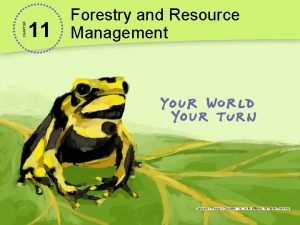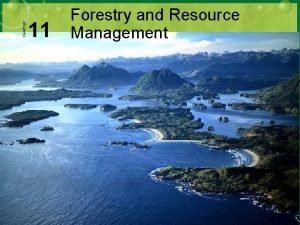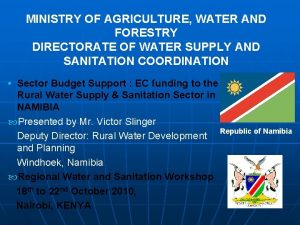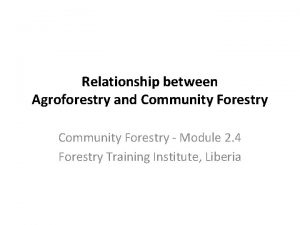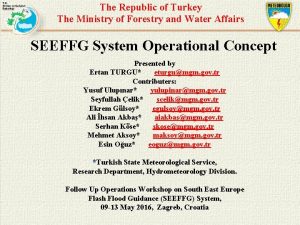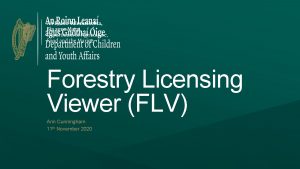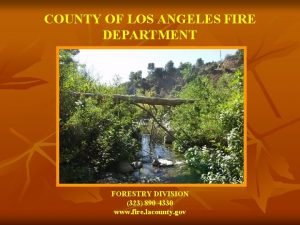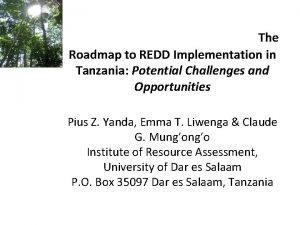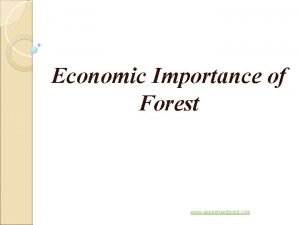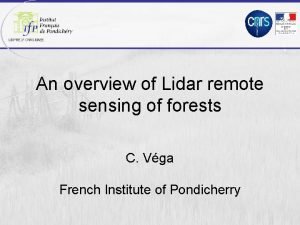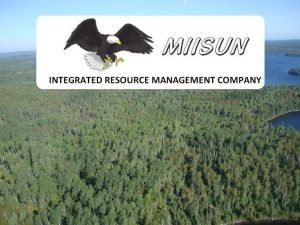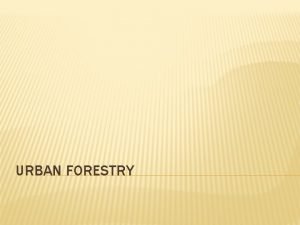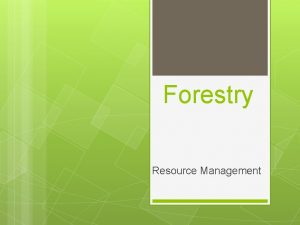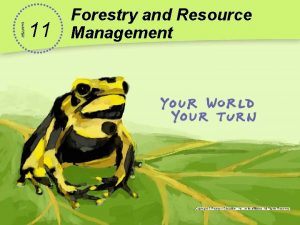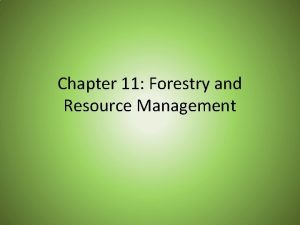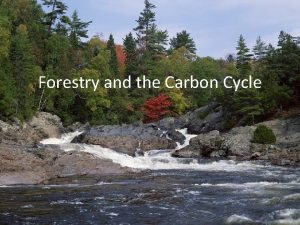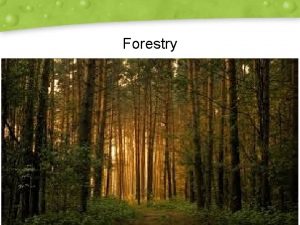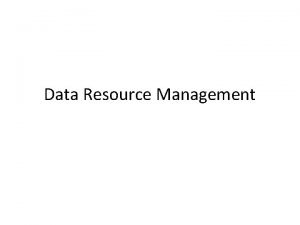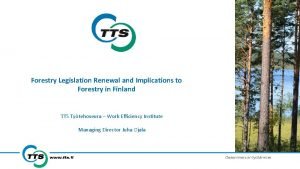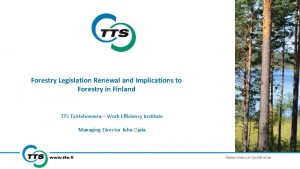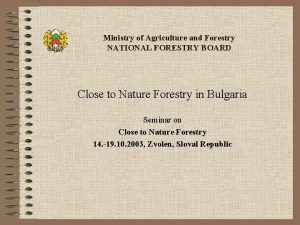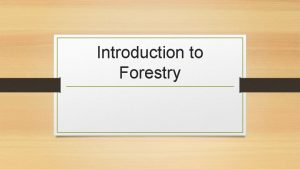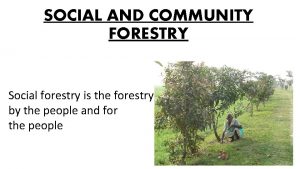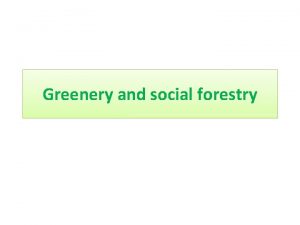CHAPTER 11 Forestry and Resource Management Lesson 11

















- Slides: 17

CHAPTER 11 Forestry and Resource Management

Lesson 11. 1 Resource Management Overfishing has reduced populations of North Atlantic cod, an economically important fish, by 60% over the last 40 years.

Lesson 1 Objectives • Explain the importance of managing specific renewable resources. • Describe three resource management approaches

Lesson 11. 1 Resource Management Renewable Resource Management • Resources are either renewable, such as soil, or nonrenewable, such as fossil fuels. • Goal is sustainability— resource use that occurs only as fast as can be naturally replaced. • Must balance human and ecological needs Did You Know? More than 8 million hectares of forest were lost between 1990 and 2005.

Lesson 11. 1 Resource Management Maximum Sustainable Yield (MSY) • Goal: To harvest maximum resources without compromising future harvests • Population sizes are kept far below carrying capacity, enabling fast growth. • MSY can affect interactions between species and alter entire ecosystems. • Determining target population size is largely a matter of trial and error.

Lesson 11. 1 Resource Management Ecosystem-Based Forest Management • Goal: To harvest resources while minimizing effects on the rest of the ecosystem • Ecologically sensitive areas are carefully monitored and protected; resources are harvested selectively. • Ecosystems are complex, so choosing which areas to protect and which to harvest is a challenge.

Lesson 11. 1 Resource Management Adaptive Forest Management • Goal: To gather data from areas managed in different ways, and develop a customized management plan based on the results • Management practices are continually monitored and adjusted. • Can be time-consuming and may require changing established practices

Lesson 11. 2 Forests and Their Resources Forests, mostly boreal forests and tropical rain forests, cover about 30% of Earth’s land.

Lesson 2 Objectives • Discuss the current levels of deforestation in the united states and in developing nations

Lesson 11. 2 Forests and Their Resources Value of Forests • Ecological value: • • • Provide habitat for organisms Source of biodiversity Prevent erosion Purify water Store carbon, release oxygen • Economic value: • Timber for lumber and fuel • Source of food • Raw material for many medicines

Lesson 11. 2 Forests and Their Resources Timber Harvesting Methods • Three methods: Clear-cutting, seed-tree or shelterwood approach, and selection system • May result in even-aged or uneven-aged regrowth • Even-aged regrowth tends to be less biodiverse than uneven-aged regrowth. Did You Know? Today most commercial logging in the U. S. occurs in western coniferous forests and southern pine plantations.

Lesson 11. 2 Forests and Their Resources Clear-Cutting • Involves cutting down all trees in a region, resulting in even-aged stands of regrowth • Changes abiotic conditions in the area, including light penetration, precipitation, wind, and temperature • Benefit: Cost efficient • Costs: Entire communities usually displaced or destroyed; causes soil erosion.

Lesson 11. 2 Forests and Their Resources Seed-Tree and Shelterwood Approaches • Seed-tree: Small numbers of mature, healthy trees are left standing, to reseed the area. • Shelterwood: Involves leaving a few mature trees standing to provide shelter for seedlings • Benefit: Less damaging than clear-cutting • Cost: As with clear-cutting, leads to mostly even-aged regrowth

Lesson 11. 2 Forests and Their Resources Selection Systems • Relatively few trees are cut at once under a selection system. • Selection can involve widely spaced single trees or groups. • Benefits: • More biodiverse, uneven-aged growth • Less overall environmental damage • Costs: • Machinery disturbs forest interior. • Expensive process • More dangerous for loggers

Lesson 11. 2 Forests and Their Resources Deforestation • Unlike timber harvesting, deforestation replaces forested areas with some other land use, such as commercial or residential property. • Deforestation in tropical and arid regions has the most negative effects due to loss of biodiversity and desertification risk respectively. • Globally, deforestation adds CO 2 to Earth’s atmosphere.

Lesson 11. 2 Forests and Their Resources Deforestation in the United States • Deforestation for timber and farmland facilitated U. S. expansion. • Wood felled for buildings and fuel during the pre- and early Industrial Revolution periods. • By the early 1900 s, very little old-growth forest (forest that has never been logged) remained in the United States. Did You Know? Once old-growth forest is logged, it may need hundreds of years to regrow.

Lesson 11. 2 Forests and Their Resources Deforestation in Developing Nations • Timber from old-growth tropical rain forests is a source of income in developing nations. • Advanced technology enables deforestation to occur faster than it has in the United States. The border bewteen Haiti (left) and the Dominican Republic (right) shows Haiti’s deforestation. • Deforestation of tropical rain forests has an enormously negative effect on global species diversity.
 Forestry and resource management chapter 11 answers
Forestry and resource management chapter 11 answers Battling over clayoquot big trees worksheet answers
Battling over clayoquot big trees worksheet answers Ministry of agriculture, water and forestry directorates
Ministry of agriculture, water and forestry directorates Mendel university of agriculture and forestry
Mendel university of agriculture and forestry State and private forestry
State and private forestry Difference between agroforestry and community forestry
Difference between agroforestry and community forestry Maine department of agriculture conservation and forestry
Maine department of agriculture conservation and forestry Eturgu
Eturgu Resource allocation vs resource leveling
Resource allocation vs resource leveling Perbedaan resource loading dan resource leveling
Perbedaan resource loading dan resource leveling Tending operations in forestry ppt
Tending operations in forestry ppt Flv viewer
Flv viewer La county forestry
La county forestry Forestry io roadmap
Forestry io roadmap Careers related to forestry
Careers related to forestry Importance of forestry
Importance of forestry Lidar
Lidar Miisun
Miisun
